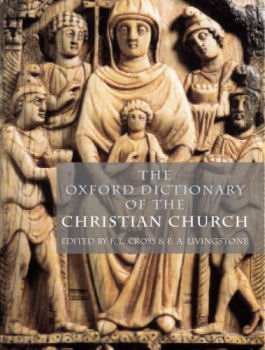
|
Posted December 4, 2005
Book: The Oxford Dictionary of the Christian Church: Third Edition Revised Edited by F. L. Cross & E. A. Livingstone Oxford University Press, NY, 2005 An Excerpt from the Jacket:
More Than 6,000 Entries Cover: Theology The development of doctrines throughout the ages; spirituality and heresy; the history of the Reformation and Counter-Reformation. The Bible Individual Biblical Books; major figures from Abraham, Moses, and King David to St. Paul and the Evangelists; schools of Biblical criticism and entries on their chief exponents. Patristic Scholarship Major Fathers of the Church and their teaching; the Nag Hammadi papyri and their significance for our understanding of Gnosticism; the problems of Macarius of Egypt and Macarius/Simeon; the recently discovered sermons of Augustine. Churches and Denominations The beliefs and structures of mainstream and lesser-known denominations such as Amish, Muggletolnians, Shakers, and Wee Frees; the history of Christianity throughout the world, in countries such as Angola, Canada, Ireland, New Zealand, the Philippines, Poland, Spain, the United States, Vietnam, and Zaire. The Church Calendar and Organization Feast and saints’ days; Sacraments; church services, offices, rites, and practices; canon law including Catholic revision; councils and synods, religious orders. Biographical Entries Saints, popes, patriarchs, and archbishops; emperors, kings, and other rulers; mystics, heretics, and reformers; theologians and philosophers with a summary of their opinions; artists, poets, and musicians. An Excerpt from the Book: Homosexuality There are few biblical references to homosexual behavior. In the OT the definite references are in the story of Sodom in Gen 19: 4-11, the probably dependent incident recorded in Jgs. 19, and in Lev. 18:22 and 20:13. Both the infrequency of the references and their contexts encourage the view that this was not a subject of great concern to OT writers, and although later Christian exegesis used the condemnation of Sodom as evidence of particular Divine displeasure at the homosexual assault intended by its inhabitants, the story itself does not emphasize this particular sin nor does subsequent OT reflection on it (Is. 1, Ezek. 16, and Jer. 23). In the NT homosexual behavior is mentioned and condemned in 1 Cor. 6: 9-11, I Tim 1: 10 and most influentially in Rom. 1:27 which many moralists have seen as supporting the view that homosexuality is with other sexual acts which are not procreative, contrary to "Natural Law." Patristic, medieval, and later Christian moralists have not questioned this judgement, and it is only in recent times that some writers have argued that the quality of a relationship, be it homosexual or heterosexual is what determines its moral value. Whether they have taken this view or have continued to regard homosexual behavior as sinful, Christian Churches have usually favored the reform of civil law which has occurred in many countries, removing the harsh penalties previously imposed. In England the Churches played a significant part in supporting the appointment of the Committee responsible for the Wolfenden Report of 1957 and the enactment of its recommendations as the Sexual Offences Act 1967, which removed criminal sanctions from homosexual behavior between consenting adults in private. These developments have been accompanied by changes in attitude among psychiatrists, who no longer tend to regard homosexual leaning as something to be cured. In 1991, the House of Bishops of the General Synod of the C of E, while emphasizing that ‘homophile’ [i.e., homosexual] orientation and its expression in sexual activity do not constitute a parallel and alternative form of human sexual activity as complete, within the terms of the created order as the heterosexual’, nevertheless did not reject homosexual activity in permanent relationships among the laity, but insisted that the clergy have the particular responsibility to maintain the Scriptural ideal; they ‘cannot claim the liberty to enter into sexually active homophile relationships’. The 1998 Lambeth Conference, however, expressed the belief that for all Christians ‘abstinence is right for those not called to marriage’, while accepting that some experience themselves as having a homosexual orientation, the Conference rejected ‘homosexual practices as incompatible with Scripture. |
|
